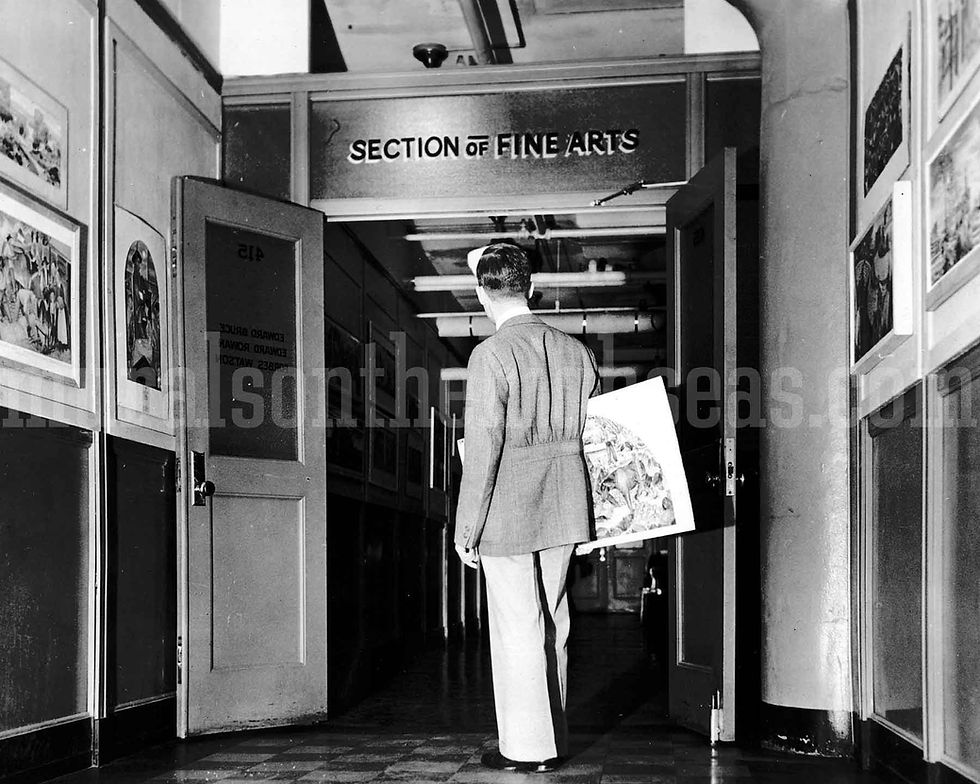
FDR'S New Deal: The Arts and the Maritime Commission
One of the components of President Roosevelt's New Deal program placed the artist on the same level as bricklayers, electricians, plumbers, and other professions charged with rebuilding the nation's infrastructure. A variety of art programs helped keep our artists at their craft, whether it be easel painting, sculpture, or murals. It is not an understatement to say that without these federal programs, a generation of talent would have been lost.
Coming off the massive appeal of 1939's 48-State Competition, a national contest that put a mural in a freshly built post office in each of the contiguous 48 states, the Section of Fine Arts took notice of the Maritime Commission's building program.
Subtle calls for using federal competitions to decorate American passenger ships had been sounding since Queen Mary's debut. The May 1, 1936 issue of Art Digest said of the British output for the ship, "The harmony between setting and subject which these artists have achieved may hold a valuable lesson for the directors of the Federal Government's hundreds of public art projects." (Now, it could be argued the artworks were British through an American lens. It was projected the bulk of First Class passengers would be American, thus Cunard asked our side of the pond for advice.)
Two years later, the July 1938 issue of Magazine of Art, while singing the praises of Norwegian America Line's Oslofjord, chided the United States's lack of effort in passenger ship decor:
"In many instances the finest talent of the country is recruited and every effort made to reflect the best in native taste and culture ... however, the United States has been curiously indifferent to the possibilities in this field, with the result that American artists and designers have had little opportunity to show what they could do. Considering the success of competitions for the decoration of public and private buildings, efforts along the same lines for our forthcoming new passenger ship might bring some worthwhile results."
The ship in question was United States Lines' America, which will be discussed further in the 1940s. America was the first ship in the U.S. Maritime Commission's rebuilding of the nation's merchant fleet. round the same time, the government took over the fading Dollar Line and its aging fleet of President liners. Dollar Line was renamed American President Lines, and after a lengthy discussion on essential trade routes, an order was placed for seven modified C-3 passenger-cargo ships for APL's round-the-world route at the Newport News Shipbuilding and Dry Dock Company.
It was in these seven ships, the President Jackson-class, that Edward Bruce saw a future for his Section of Fine Arts. Up for grabs were seven spandrels and an overmantel in the main lounge, two panels for the bar, a mural for the library, and a mural plus two circular panels for the dining room.
For the first six ships, 22 artists received 30 commissions. Somewhere along the line, President Polk was kicked down to a lower status, with only two commissions awarded, for bar panels and the overmantel.

Main entrance to the Section of Fine Arts offices. The following images are from the 48-States Competition and are a good indication of how things worked for the President Jackson Competition. (pv)

With their entry, artists submitted a sealed envelope with their name and address. They would not be opened until the jury reached their decision. (pv)

Bulletin 22, which came out in September 1940, announced winners for the first six ships of the President Jackson-class. Thirty commissions, for a total of 72 artworks, were given to 22 artists. (mc)

Main entrance to the Section of Fine Arts offices. The following images are from the 48-States Competition and are a good indication of how things worked for the President Jackson Competition. (pv)
One by one, starting in December 1940, the class entered service. President Adams was the exception as the Navy requisitioned the ship just as it was to be handed over. When we finally entered World War II, the ships were converted to attack transports admirably serving in the Atlantic and Pacific theaters. The Van Buren suffered a torpedo hit off the coast of Algeria and was declared a total loss after being bombed during an air raid.
After the war, only the Monroe and Polk returned to APL; the rest ferried troops and their dependents to and from Europe and Asia. By the end of the 1950s, President Jackson, President Hayes, President Garfield, and President Adams were laid up in Suisun Bay, California. By the mid-1970s, the President Jackson-class had met their end in scrapyards in this country and around the world.
The Section may not have been able to pull off this competition if it were any other shipping company, for APL was owned by the government, salvaged from the remnants of the Dollar Steamship Line. In this regard, however, both the Section and the Maritime Commission's Interiors & Styling Unit were seriously encroaching in matters usually the domain of the private sector.
And yes! You'll notice the photos of the mural entries are a bit skewed. Over the years, photos, when stored on edge in a file folder, will bend and acquire an annoying curl. Playing safe with the budget, the decision was made not scan them. (Where they would flatten out under the pressure of the scanner lid.) Several hundred photos at a quarter a pop adds up fast. This situation will be rectified in the near future, but you'll get the idea of what was intended. But know this, the last time some of these competition entries were published was back in 1941.
